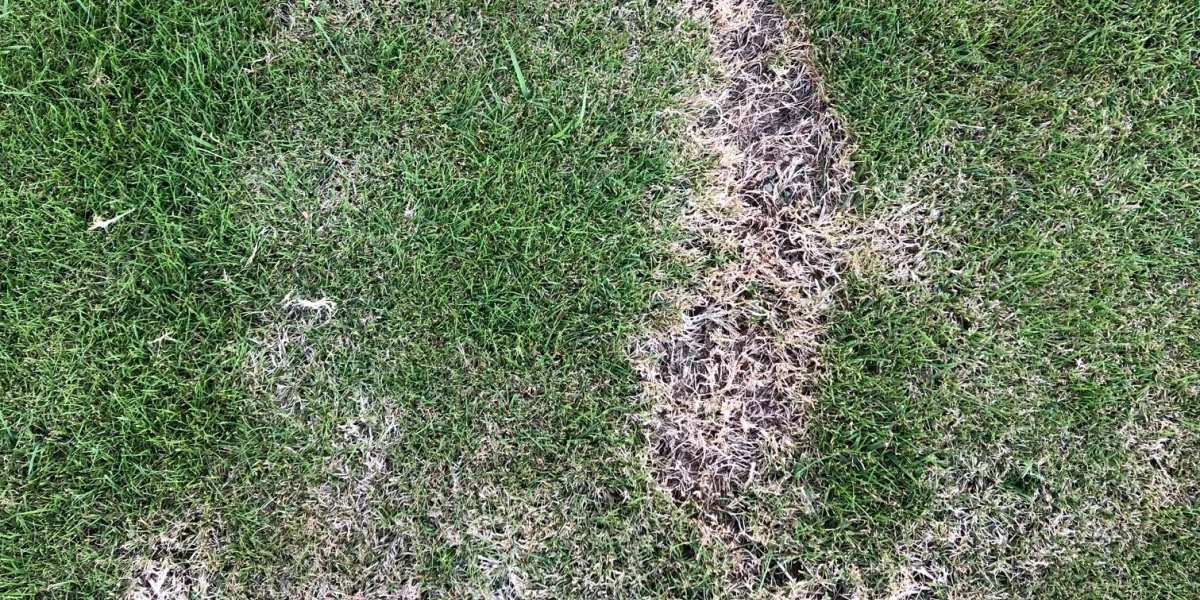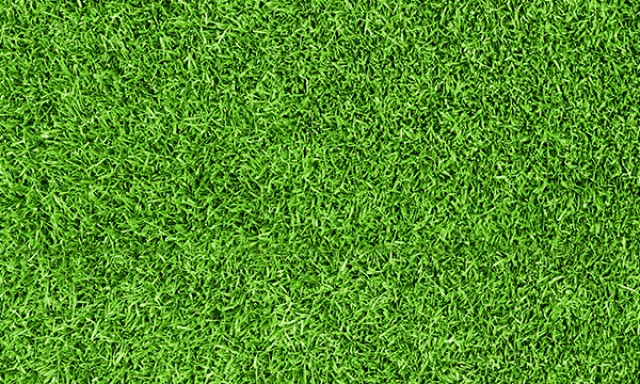Brown Patches in Your Lawn?
We all want our lawns to be an even, vibrant green, carpet of grass, and to achieve this we might put great effort into watering, mowing, fertilising, controlling weeds, scarifying, forking, etc. But sometimes, even with all this effort, the lawn gets brown patches. It is not always obvious what the cause of the patches is. Here are the possible causes of brown patches in your lawn, how to identify the problem and what you can do to solve the problem. You will notice that the superficial symptoms are similar for many of the causes and further investigation is required.
Download a presentation on identification of lawn problems and how to solve them
- Symptoms/Identification:
- Mottled patches of yellow to brown and dead grass.
- Affected grass pulls up easily as the roots have been eaten by the grubs.
- Damage tends to occur in spring and autumn.
- C-shaped pale cream grubs with brown heads found in soil.
- Dig out 20 cm x 20 cm (spade square) sods in affected areas – greater than 5 grubs.
*There are other beetle grubs that cause similar damage; black beetle, Tasmanian grass grub, striped chafer etc.
- Solution/s:
- Apply LawnPro Protect at 100 g per 15 m2 on the lawns you wish to protect from grass grub. Ideal for use from February to late Autumn but can be used effectively through to Spring and Summer. The granules must be watered in, so sprinkle before moderate to heavy rain (10 mm) or water the area thoroughly after treatment with a sprinkler.
- Symptoms/Identification:
- Mottled patches of yellow to brown and dead grass.
- Tunnels in the affected areas that look like a pen or pencil have been pushed into the soil. There may be piles of soil at the entrances to the tunnels. The caterpillar lives in the bottom of the tunnels and emerges at night to feed on the crowns of the grass.
- Roots are not eaten so grass does not pull up easily.
- Damage occurs in autumn and early winter.
- Solution/s:
- Apply LawnPro Protect at 100 g per 30 m2 on the lawns you wish to protect from grass grub. Ideal for use from February to late Autumn. The granules must be watered in, so sprinkle before moderate to heavy rain (10 mm) or water the area thoroughly after treatment with a sprinkler.
- Symptoms/Identification:
- Mottled patches of yellow to brown and dead grass.
- Edges of patches may have red/pink colouration of red spores.
- Affected grass may feel slimy.
- Damage tends to occur on warm moist conditions (spring and autumn).
- Solution/s:
- LawnPro Fungus Control and LawnPro Mossclear can also be used to control the spread of red thread in lawns. It will kill the spores of the fungus.
- Symptoms/Identification:
- Patches of yellow to brown and dead grass. Patches grow to up to 1 metre diameter and may merge.
- Roots of grass tend to turn black.
- Solution/s:
- LawnPro Fungus Control and LawnPro Mossclear can also be used to Control/s the spread of red thread in lawns. It will kill the spores of the fungus.
Other Diseases
There are various other lawn diseases including dollar spot, Fusarium, snow mould and Pythium greasy spot, that also cause affected patches on lawns. These have specific symptoms which make then generally easier to identify.
- Symptoms/Identification:
- Dollar spot – small (3-5 cm diameter) circular brown patches.
- Fusarium – circular orange/brown patches 5 cm up to 30 cm diameter.
- Snow mould – circular dead patches with pink tinge around edges.
- Pythium greasy spot – grass slimy and turning brown to grey to black.
- Melting out (aka Leaf spot) - purple-brown blotches on grass blades, rapid browning off of mottled patches where grass flattens as if it has 'melted'.
- Solution/s:
- LawnPro Fungus Control and LawnPro Mossclear can also be used to Control/s the spread of red thread in lawns. It will kill the spores of the fungus.
- Some thatch (less than 2 cm) is good for your lawn. Soil dwelling organisms break the thatch down into humus which helps nourish both the grass and the beneficial organisms in the soil which helps keep the soil and the grass healthy. If the thatch builds up faster than it is broken down and it exceeds 2 cm depth, the layer can begin to cause problems for the lawn; the lawn becomes spongy and retains moisture that encourages fungal disease of the grass, insect pests can harbour in the thatch, the grass struggles to grow through the thatch and oxygen is less able to penetrate the soil below and roots and beneficial organisms may suffer in anaerobic conditions.
- Apply LawnPro D-Thatch or Turfclean & Green Rapid+ to the affected areas of lawn. This naturally encourages the breakdown of excessive thatch by beneficial soil organisms and restores the balance of breakdown to build-up.
- Symptoms/Identification:
- Brown or dead circular patches. Ring of grass around patches is dark green.
- Solution/s:
- The urine of some animals, particularly female dogs, can have high nitrogen levels which burn the grass. Keep pets off the lawn.
- Reduce the application of nitrogen fertiliser so the grass can better cope with the urine.
- NO Cats & Dogs animal repellent can deter animals for toileting in treated areas.
- Symptoms/Identification:
- Constant use or items left on lawns that stop light getting the lawn can cause browned or dead patches.
- Soil tends to be compacted.
- Solution/s:
- De-thatch the worn area to remove dead grass material. Rake the dead grass out in small areas or use a mechanical de-thatcher for larger areas.
- Aerate the soil - use a garden fork and insert the fork into the soil 10-15 cm and ease the fork back gently to open up the soil. Do this at 30 cm intervals across the lawn and particularly in the worn areas.
- Alternatively, you can use a mechanical lawn aerator (these are readily available for hire).
- Water thoroughly to get the deep soil moist.
- When the grass has dried apply LawnPro Smart Patch Mix, LawnPro Lawn Thickener or LawnPro Smart Seed to the worn patches and water again gently.
- Stay off the treated area of the lawn until the new seed has established; usually 6-8 weeks.
Mower Scalping
- Symptoms/Identification:
- Lighter coloured grass or browned-off grass at high spots on the lawn. Hollows are still green.
- Solution/s:
- Raise mower height. Never mow off more than 1/3 the height of the grass.
- For most New Zealand lawns, cut the turf to a height of 4 cm as needed in winter, and to 2-3 cm on a weekly basis during spring and autumn. Mow when the grass has grown by 30%, so you don’t have to cut off more than one-third of the blade.
- Apply top dressing to the hollows on the lawn to, over time, level the lawn off.
Over Mulching During Mowing
- Symptoms/Identification:
- Leaving too many clippings on the lawn can cover lawn grass and create conditions for diseases to flourish. Thatch build-up begins when organic debris builds up faster than it can be broken down. This can cause brown off.
- Solution/s:
- Mulch only when you are trimming the lawn. Cutting a small amount of grass off the top will produce short clippings that will fall through the grass to the soil surface; being small they will be easily broken down and incorporated into the soil.
- See the article 'To Mulch or Not to Mulch?' for more information.
Nutrient Deficiency
- Symptoms/Identification:
- Nutrient deficiencies will cause lawn grasses stress, yellowing/browning and dying off.
- Nitrogen deficiency – lawn goes pale and patchy.
- Phosphorous deficiency – slow growth and burnt look.
- Potassium deficiency – wilting and discolouration of grass.
- Solution/s:
- Apply appropriate lawn fertiliser. LawnPro 7-Day-Green is ideally balanced for providing nitrogen, phosphorus and potassium (plus other nutrients) to lawn grasses and promoting green, lush dense lawns.
Fertiliser Burn
- Symptoms/Identification:
- Over application of fertiliser can ‘burn’ grasses; causing discolouration and potentially death.
- Nitrogen – browning off of lawn grass.
- Iron – blackening of lawn grass.
- Solution/s:
- Care should be taken when applying fertilisers to lawns. Follow application rate instructions.
- Use low NPK fertiliser such as LawnPro 7-Day-Green frequently, instead of high NPK fertiliser.
Soil pH (acidity/alkalinity)
- Symptoms/Identification:
- Acidity/alkalinity is measured by pH. pH below 7 is acidic and above 7 is alkaline. While fine fescues prefer pH of low acidity down to 5.5 most lawn grasses prefer neutral pH between 6.5 and 7.0.
- Acidic soil below 6.5 may cause deficiency of calcium, magnesium and phosphorus in lawn grass. This will show as pale weedy lawn grass.
- Alkaline soil may cause deficiency of iron, zinc, copper and manganese in lawn grass. Iron chlorosis (loss of green colour) in the grass, caused by inadequate iron, is a common problem in alkaline soils.
- Solution/s:
- Acidic soil:
- Raising soil pH and improvement of soil condition can be accomplished by the addition of lime to the soil. Lime has a high pH and will 'sweeten' the soil by raising the pH. Kiwicare LawnPro 7-Day-Green is 70% lime. The lime neutralises the acidic soil and helps release nutrients that the lawn grass may be deficient in
- Alkaline soil:
Plain elemental sulphur (or sulphur) is probably the easiest and most common way to lower the pH of soil. It can be spread on top of the soil. Sulphur is slow-acting, you should not apply more than 1 kg per 10 m2 at any time. - Acidifying Fertilizer. Fertilizers that contain ammonia (such as ammonium nitrate), urea, or amino acids will have an acidifying effect on the soil in your lawn. LawnPro All-in-1 can be used to reduce soil pH.
- Mulches and Compost - When organic matter breaks down, it tends to make the soil more acidic. Regular use of organic compost and mulches will bring the soil pH closer to the neutral to slightly acidic level levels suitable for lawn grasses.
Drought
- Symptoms/Identification:
- Low soil moisture levels will cause lawn grass to brown off.
- Winter grasses are more prone to drought and browning in summer than summer grasses.
- Solution/s:
- In warmer drought-prone areas consider lawns of summer grass such as Kikuyu.
- Regularly water the lawn. Apply a good soaking irrigation 2-3 times a week, not a little more frequently; this encourages deep rooting of grass and drought tolerance.
- Apply irrigation in the mornings so that the lawn grass dries off. Lawn left wet overnight would encourage disease.
- Do not cut lawns too short (see Mower Scalping above).
David Brittain
Kiwicare


